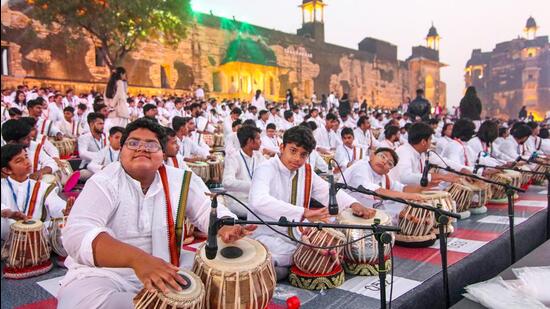Description

Disclaimer: Copyright infringement not intended.
Context
- Around 1,300 tabla players joined forces at the 99th International Tansen Mahotsav in Gwalior to set the Guinness World Record for the "largest table ensemble."
- The feat, accomplished during the ongoing festival, showcased Gwalior's musical prowess.
Details
UNESCO Recognition
- Gwalior recently gained recognition as the "Creative City of Music" in UNESCO's Creative Cities Network (UCCN) in November, elevating its status in the realm of music and culture.
- The festival's celebration of Gwalior's musical heritage and the UNESCO designation highlight the city's rich artistic and cultural contributions.
Legacy of Music Promotion
- The erstwhile Scindia family has historically played a pivotal role in nurturing music in Gwalior, fostering the city's musical heritage.
- From pioneering solo harmonium playing in India to supporting Khayal singing, the family's contributions to Indian classical music remain significant.
- Maharaja Madho Rao Scindia played a key role in founding the Shri Madhav Music School in Gwalior, a testament to the family's dedication to music education.
- Bhatkande's collaboration with Madho Rao Scindia led to the establishment of a music college in Gwalior, furthering the city's musical legacy.
- Maharaja Jiwajirao Scindia and his wife, former Rajmata of Gwalior Vijaya Raje Scindia, continued the family's passion for music, fostering an environment of musical appreciation.
Recognition
- Madhya Pradesh Chief Minister received the Guinness World Records certificate, announcing December 25 as "Tabla Day" to be celebrated annually in Madhya Pradesh.
- This celebration not only signifies the achievement but also promotes the importance of tabla and music in the state's cultural heritage.

Tansen Samaroh
- Occasion: Tansen Samaroh or Tansen Sangeet Samaroh is an annual music festival held in Behat village of Gwalior district, Madhya Pradesh, typically in December.
- Duration: This extravaganza spans four days, dedicated to commemorating the legendary Indian musician, Tansen.
- Purpose: The festival serves as a tribute to the renowned Maestro, drawing artists and music aficionados from around the globe.
Organizers and Venue:
- Hosting Entity: The event is organized by the Ustad Alauddin Khan Kala Evam Sangeet Academy under the department of culture, Government of Madhya Pradesh.
- Location: Held near the tomb of Tansen, the festival's venue holds cultural significance due to its proximity to the great musician's resting place.
Evolution into a National Festival:
- Origins: Initially, Tansen Samaroh was a local celebration.
- National Recognition: It gained national prominence thanks to BV Keskar, the Union Minister for Information and Broadcasting (1952-1962). His initiative transformed the festival into a prominent national music festival.
About Tabla
- Definition: The tabla is a pair of small, hand-played drums widely utilized in Hindustani classical music, originating from the Indian subcontinent.
- Physical Structure: It consists of two distinct drums: the smaller, higher-pitched drum called the "dayan" or "tabla," and the larger, deeper-pitched drum called the "bayan" or "dagga."
- Construction: The dayan is traditionally made from wood and played with the dominant hand using the fingertips and palm. The bayan, a larger drum, is made of metal and played with the non-dominant hand using the wrist and fingertips.
Historical Evolution:
- Origins: The tabla has a rich history dating back several centuries, evolving from the ancient Indian percussion instrument called the "pakhawaj."
- Development: Over time, the pakhawaj underwent changes in size, structure, and playing techniques, leading to the creation of the tabla in its current form.
Playing Techniques and Styles:
- Finger Techniques: Tabla players use a variety of finger strokes, including "bols" (syllables) such as "Na," "Tin," and "Tun," producing diverse sounds and rhythms.
- Genres and Styles: It is a versatile instrument, adaptable to various musical genres, including classical, folk, and fusion music. Tabla players showcase their expertise through intricate compositions, improvisations, and accompanying other musicians.
Structure and Notation:
- Taals: Tabla compositions are often structured in rhythmic cycles known as "taals," each cycle having a specific number of beats. Common taals include "Teen Taal" (16 beats) and "Ek Taal" (12 beats).
- Taal Notation: Tabla compositions are traditionally conveyed through a system of notation known as "bols," representing specific strokes and compositions.
Renowned Tabla Maestros and Schools:
- Legendary Tabla Maestros: Prominent tabla virtuosos like Ustad Zakir Hussain, Pandit Anindo Chatterjee, and Ustad Alla Rakha have achieved international acclaim for their mastery of the instrument.
- Gharanas (Schools): Various tabla-playing traditions, known as "gharanas," such as Delhi, Ajrada, Farrukhabad, and Punjab, have distinct playing styles and techniques.

About Tansen
Early Life and Education:
- Birth and Origins: Born as Ramtanu Pandey in Gwalior, Madhya Pradesh, around 1506–1509.
- Musical Initiation: Started his musical journey under the guidance of Swami Haridas, a revered saint and musician known for his expertise in Indian classical music.
- Further Training: Received advanced musical education from Hazrat Muhammad Ghaus, a prominent musician and scholar, refining his skills and knowledge.
Musical Accomplishments and Mastery:
- Versatility in Musical Forms: Proficient in various musical forms like dhrupad, dhamar, and khayal, showcasing his mastery and versatility.
- Innovative Contributions: Credited with the creation of several ragas, including Miyan ki Todi, Miyan ki Malhar, Miyan ki Sarang, and Darbari Kanada, each contributing significantly to Hindustani classical music.
Service in Akbar's Court:
- Courtier and Musician: Elevated to the esteemed position of one of the navaratnas (nine gems) in Emperor Akbar's court, where he served as a chief musician.
- Emperor's Esteem: Held in high regard by Akbar for his exceptional musical talent and reputed mystical influence through his music.
Legends and Anecdotes:
- Mythical Influence: Legends abound about Tansen's music having mystical effects, such as his rendition of raga Deepak, believed to ignite lamps and evoke rainfall, and raga Todi, known to calm elephants.
- Impact on Nature: His performances were said to have the power to control nature and influence living beings.
Enduring Legacy:
- Gwalior Gharana: The Gwalior gharana, a significant school of Hindustani classical music, traces its lineage and musical traditions back to Tansen, preserving his teachings and musical legacy.
- Continued Influence: His compositions and musical innovations continue to be an integral part of Indian classical music, inspiring musicians and enthusiasts across generations.
Conclusion
The achievement of the Guinness World Record at the Tansen Mahotsav adds another feather to Gwalior's cap, reinforcing its position as a hub of musical excellence and innovation. The city's rich heritage, coupled with ongoing initiatives, continues to showcase its dedication to preserving and celebrating India's musical legacy.
|
PRACTICE QUESTION
Q. Discuss the significance of Gwalior being recognized as the "City of Music" and its contribution to India's cultural heritage. How has the city's rich musical legacy influenced its socio-cultural fabric and contributed to the promotion and preservation of Indian classical music? (250 Words)
|















